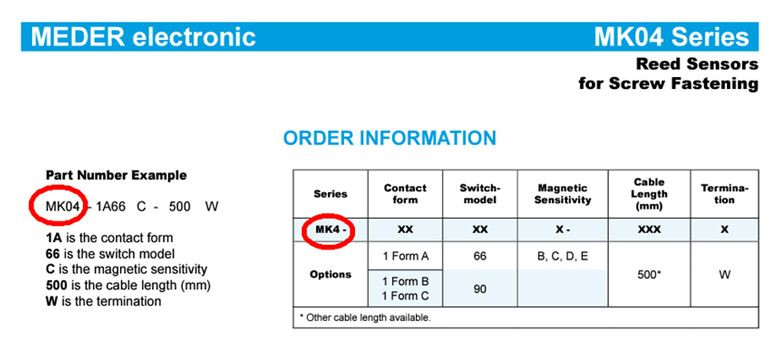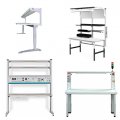
Reed sensors MK04 and magnet M04 Standex-Meder
Reed contacts are distinguished by many properties that significantly surpass standard switching technologies. Standex-Meder components, moreover, belong to the top in this segment.
A reed contact can be considered a "sensor" controlled by a magnetic field, most commonly a permanent magnet or a coil, creating a reed relay.
Components with reed contacts can be divided into three basic groups:
- Reed contacts,
- Reed sensors,
- Reed relays.
"Reed contacts operate on the principle of deformation of magnetically conductive reeds in a magnetic field. We can say that most exceptional properties of reed contacts stem from the fact that the contacts themselves are small, light, and spaced only a few hundredths of a millimeter apart (in the case of small types). They are also hermetically sealed in a glass capsule in a vacuum or more commonly filled with an inert gas. Thanks to this construction, Standex-Meder reed contacts, as well as reed relays and reed sensors, are characterized by very good properties," says Pavol Buhla, product specialist manager at SOS electronic.
For more general information about Standex-Meder products, you can refer to our previous articles.
Where can we use reed sensor?
It is one of the most widespread solutions using reed contacts and serves primarily as part of security systems on doors and windows of buildings. Another possible use is as a limit or position switch in pneumatic or hydraulic equipment, but you can also find them in washing machines or dishwashers.
How does the MK04 Standex-Meder reed sensor work?
The MK04 sensor is mounted on the stationary part of the device using screws. The terminal is typically a 0.5-meter cable. The sensor has one switching contact – in the rest position (with the magnet distant), it is open. The contact can handle a continuous current of 0.5 A and a voltage of 180 Vdc. The maximum power load is 10 W.
The permanent magnet is logically mounted on the moving part of the device, such as the door or window panel, also using two screws. Both elements are sold separately. The UL certification is a bonus.
Key features of reed sensors MK04 Standex-Meder:
- Contact: 1A (SPST) normally open (N. O.), there is also 1B (SPST) normally closed (N. C.), as well as 1C (SPDT) changeover
- Magnetic features: 10 – 15 At (ampere-turns)
- Maximum current: 0,5 A
- Maximum voltage: 180 V (DC or AC peak)
- Maximum power: 10 W
- Contact resistance in switched state: max. 150 mΩ
Marking MK4 versus MK04. Don’t be mistaken
You may come across reed sensors where you'll be surprised to find either MK4 or MK04 written on them. However, they are still the same models. Even the manufacturer lists both designations in their datasheet. The same applies to the magnet – you may encounter both M4 and M04.

We will stick to the fact that the current catalog list indicates MK04, and even on the product itself with the latest date codes, it's labeled as MK04.
Type marking of reed sensors. Our tip in conclusion
Sometimes customers consider the date code as part of the Part Number, but it's not necessary. For example, on one of the images, there is the designation: A7/2. According to the technical standard EN60062, A7 represents the manufacturing date: July 2010. The number 2 signifies the "factory code" – the identification code of the factory where the product was manufactured.
|
So, the complete marking of the reed contact is: PartNr DateCode/FactoryCode, but the type marking is determined only by PartNr.
|
The most commonly used reed contacts and magnets from Standex-Meder are available directly from our warehouse. We are happy to provide all other versions for you upon request and under favorable conditions.
Your feedback helps us create truly useful content for our readers. Appreciate the above information with an imaginary contribution for this article.
If you have any questions or comments, please don't hesitate to contact us. Thanks again for your time and trust.
Are you interested in more information about STANDEX-MEDER products or technical advice when selecting the appropriate solution? Or do you have any other questions or requests? Please fill out the following form; we will gladly assist you.
Do you like our articles? Do not miss any of them! You do not have to worry about anything, we will arrange delivery to you.



















